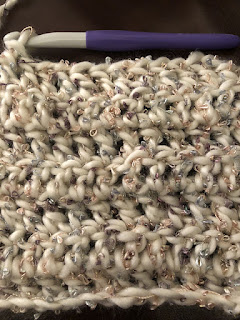Tie-Straps Headband Knit Pattern
Difficulty Level: 2 out of 4 - Advanced Beginner Level
I needed a headband that would fit even my odd shaped head. Those with buttons in the pattern were fine - until the yarn stretched out. This pattern allows you straps long enough to tie it behind your head to secure the headband! So no matter how much the yarn stretches out, you can adjust where you tie the straps! And the body of the headband is wide enough to hold hair back in a pretty but understated way. The body of the pattern is simple.
The body of the headband is also not so wide that you have that annoying gap at the back but also not so narrow that hair is spiking out on the sides.
As I said, my head is odd shaped which means, for me, many headbands slip right back off my head. I've tried my pattern with less stretchy and with more bulky yarn, and they don't grip as well - for me. But for you, they might. For my odd shaped head, I've found mixed yarns worked best. So far my two favorites have been one that was a cotton/wool mix. And the other yarn (shown above) is a wool, silk, and nylon mix. However, if you have no issues with normal headbands, a 100% acrylic yarn would work nicely for you as well!
With the abbreviations section, I have included a few how-to YouTube video's in case some beginner knitters would like to try out certain stitches. If you have any questions at all or need help, please leave me a comment and I will do my best to help you in any way I can.
Don't forget! Have fun with the pattern! I made the straps 13 inches but if you want them long enough to tie into a pretty bow, make them 16 inches long! Have fun! ~ Cindy
Gauge:
11 st and 16 rows in 2” Stockinette Stitch.
Size Headband Makes:
Straps are 1-1/4" wide. Body of headband is 2-1/2" wide. Total of about 40 inches long.
My Ravelry Profile:
My Ravelry Headband:
SUPPLIES:
Yarn: 70 – 80 yards (64-73 m) Keep it in the range of DK, Light Worsted (3). You can use 100% acrylic. Or cotton for summer. Or wool for winter. I personally like a cotton/wool mix yarn.
Knitting Needle Size: Size US 6 Needles (4 mm) – Though I often go up to US 7.
Notions:
Tapestry needle or small crochet hook – for weaving in the ends.
Stitch marker.
Tape measure.
Abbr Meaning
CO Cast On
Sl Slip
St Stitch
Sts Stitches
K knit
P purl
KW Knit Wise
Sl first st KW slip first stitch knitwise
YO Yarn Over
K2Tog Knit two stitches together
(If you are feeling ambitious, you can substitute all the SSK’s with “K2Tog-L” - Knit two stitches together Left Leaning - https://youtu.be/owAyJQAIciM (Go to minute 1:23))
PATTERN - AS FOLLOWS:
CO 8 sts
01. Sl first st KW, K7
Repeat row 1 until strap measures 13 inches long (unstretched).
02. K2, M1, K4, M1, K2
03. K3, P4, K3
04. K2, M1, K6, M1, K2
05. K3, P6, K3
06. K2, M1, K1, SSK, YO, K2, YO, K2Tog, K1, M1, K2
07. K3, P8, K3
08. K2, M1, K1, SSK, YO, K4, YO, K2Tog, K1, M1, K2
09. K3, P10, K3
10. K2, M1, K1, SSK, YO, K1, YO, SSK, K2Tog, YO, K1, YO, K2Tog, K1, M1, K2
11. K3, P12, K3
(The -/- is just to break up the pattern for readability and has no significance beyond that.)
12. K3, SSK, YO, K1, -/- YO, SSK, K2, -/- K2Tog, YO, K1, -/- YO, K2Tog, K3
13. K3, P12, K3
14. – 75. Rep rows 12 and 13 until body of headband measures 10 inches.
For the grey headband, it took about 35 repeats of rows 12 and 13 to obtain length.
However, this may vary due to yarn and size of needle you use.
Once headband is 10 inches long from stitch marker, remove it to save for later.
76. K1, SSK, K1, SSK, YO, K1, YO, SSK, K2Tog, YO, K1, YO, K2Tog, K1, K2Tog, K1
77. K3, P10, K3
78. K1, SSK, K1, SSK, YO, K4, YO, K2Tog, K1, K2Tog, K1
79. K3, P8, K3
80. K1, SSK, K1, SSK, YO, K2, YO, K2Tog, K1, K2Tog, K1
81. K3, P6, K3
82. K1, SSK, K6, K2Tog, K1
83. K3, P4, K3
84. K1, SSK, K4, K2Tog, K1
Row 85 begins the second tie strap. Place the stitch marker on the first stitch of Row 84. This allows you a way to measure when you have completed Row 85 enough times to make the tie strap 13 inches long.
85. Sl first st KW, K7
Repeat row 85 until strap measures 13 inches long (unstretched).
Then remove stitch marker.
Bind off.
Weave in tails.
Block if desired, though I haven't done so with any of my headbands so far.









